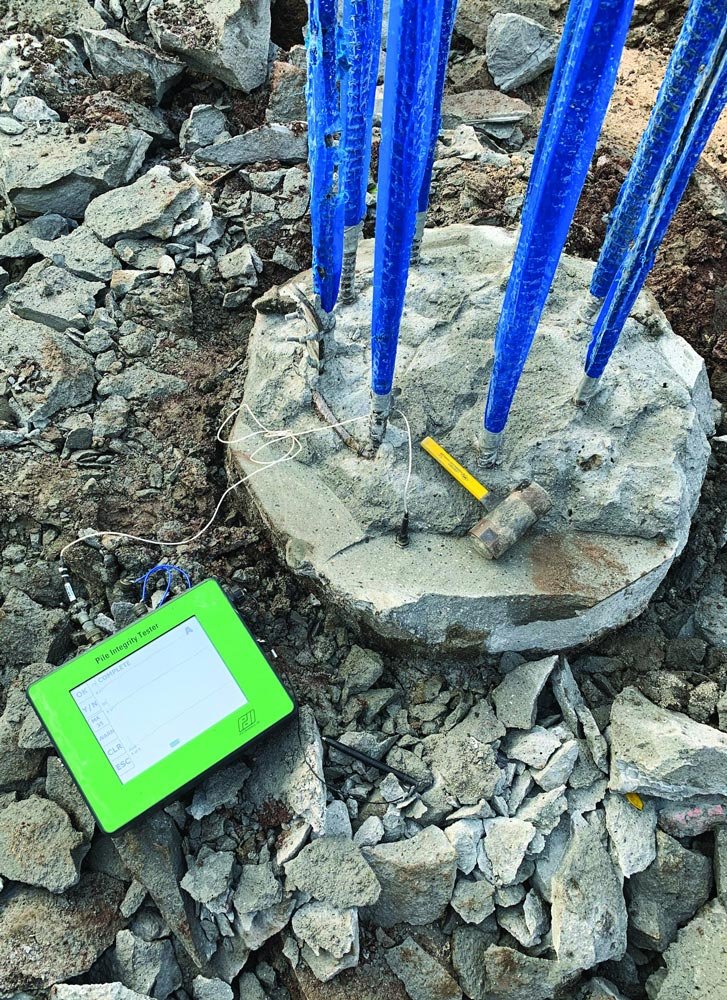
Cast-in-Place Pile Integrity
Cast-in-Place Piles and Structural Problems
As pile testing engineers, we have always been trying to answer pile contractors’ claims that “a bored or CFA pile cannot contain a defect”. They could not imagine how a hole could exist under meters of concrete pressure. In response to such claims, there are many researches and site observations that prove the existence of defects or weak material in bored piles and CFA piles. As an example, O’neill and Sarhan's studies in 2004 on more than 10000 cast-in-place piles using non-destructive tests shows that between 20 to 25 percent of piles have un-negligible flaws and defects. Also, Camp et al. findings in 2007 showed that among 441 tested piles in various projects in South Carolina State, 75 percent of projects has got at least one defective pile and 33 percent of all piles had got at least a structural issue. There are many other researches and facts that prove the construction of cast-in-place piles is a blind process that causes unwanted flaws and defects such as:
Major material changes
Local loss of cover
Large inclusions
Cold joints
Necking
Soft toe
Step 1: Preventing Integrity Issues for Cast-in-Place Piles
We all agree that “prevention, is better than cure”! To avoid structural defects in Cast-in-Situ piles, below step-by-step procedure is recommended:
First of all, construction issues that potentially could cause defects must be taken into account in the design phase, when the pile type, size, and construction method is going to be defined.
An appropriate construction method should be adopted based on the geotechnical condition of a specific site.
A proper quality control procedure and superintendence must be defined to assure the constructed piles meet design requirements.
Specific quality control technics should be considered as a part of the QA/QC plan to ensure the piles are going to be constructed properly. Pile Dynamics Inc offers three products that could be used to ensure proper pile construction, provide required QC/QA information and prevent defects:
SHAPE®
SQUID™
PIR-Q
Shaft Area Profile Evaluator (SHAPE®)
Construction of drilled shafts is a blind process. So, gathering accurate information during the drilling and concreting process is essential for the evaluation of the constructed pile. PDI offers a very useful product named SHAPE which reports quantitatively about the verticality, radius, and volume of a drilled hole prior to concreting. Visit the SHAPE product page for more information.
Shaft Quantitative Inspection Device (SQUID™)
Inspection of the bottom surface of a bored pile or drilled shaft prior to concreting is of great importance to prevent the formation of a ‘soft toe’. Soft Toe is a term that is used to describe a soil layer at pile bottom which is consisted of soft material. The material is usually originated from the fact that the bottom of the drilling length is not suitably cleaned. This results in a lack of toe resistance for the pile. SQUID measures both the thickness of soft material or debris that might be covering the bearing strata. It provides force and displacement in numerical and graphical form. An objective, quantitative assessment is reported by SQUID through accurate displacement and penetrometer pressure measurements. Visit the SQUID product page for more information.
Pile Installation Recorder (PIR-Q)
It’s essential for the quality control of augured cast-in-place (ACIP) / continuous flight auger (CFA) and drilled displacement piles to have accurate information about the actual poured concrete volume versus depth. The PIR-Q of Pile Dynamics Inc. accurately records and displays both in real-time. Visit the PIR-Q product page for more information.
Step 2: Detecting Integrity Issues of Cast-in-Place Piles
Although a complete and accurate QA/QC procedure highly reduces the probability of flaws and defects in cast-in-place piles, it does not remove them completely. So it’s necessary to test the piles with suitable methods to ensure the quality of intact piles, find defective ones, and consider suitable repair/compensation action(s). Pile Dynamics Inc. offers four products that could be tested alone or in combination for the integrity evaluation of bored piles, CFA piles, and diaphragm walls:
Pile Integrity Tester (PIT)
Cross Hole Sonic Analyzer (CHAMP-Q)
Thermal Integrity Profiler (TIP™)
Pile Driving Analyzer® (PDA)
Pile Integrity Tester (PIT)
PIT is the most common, quickest, and cheapest integrity testing method. It requires a very basic and easy pile head preparation so could be randomly applied to almost every desired pile in the project. Despite its many benefits, PIT is more subjective and less accurate in comparison to other integrity testing methods. Hence, it’s normally undertaken in combination with CSL and/or TIP. Visit the PIT product page for more information.
Cross Hole Sonic Analyzer (CHAMP-Q)
CSL provides an accurate and objective evaluation of the pile’s integrity between longitudinal rebars by lowering transmitter and receiver probes down separate tubes and raising them from the shaft bottom to the top of the access tubes. Interpretation of CSL results is straightforward and it can detect multiple defects along the shaft, between rebars. Visit the CHAMP-Q product page for more information.
Thermal Integrity Profiler (TIP™)
TIP is the latest integrity assessment product of Pile Dynamics which uses the heat generated by curing cement to assess the quality of drilled shafts. It may also be used for quality control and shape evaluation of jet grouting, slurry walls, and diaphragm walls. TIP™ evaluates the entire cross-section and the entire length of the foundation, without any L/D ratio limitations. Visit the TIP product page for more information.
Pile Driving Analyzer® (PDA)
Although PDA is mainly used to evaluate the bearing capacity of the pile, in combination with CAPWAP analysis it could provide an assessment of pile structural integrity as well. Visit the PDA product page for more information.





